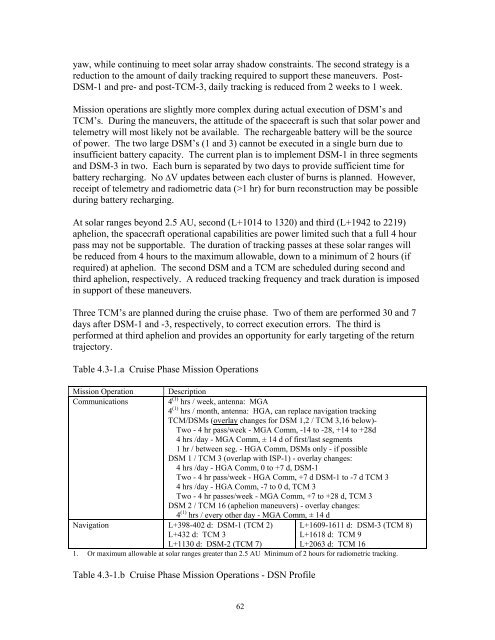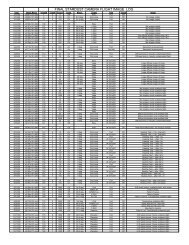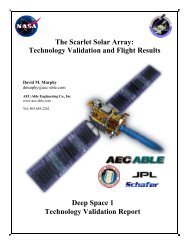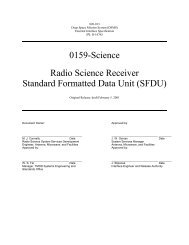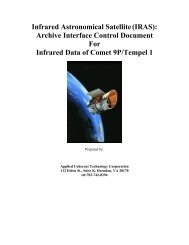MISSION PLAN - PDS Small Bodies Node
MISSION PLAN - PDS Small Bodies Node
MISSION PLAN - PDS Small Bodies Node
You also want an ePaper? Increase the reach of your titles
YUMPU automatically turns print PDFs into web optimized ePapers that Google loves.
yaw, while continuing to meet solar array shadow constraints. The second strategy is a<br />
reduction to the amount of daily tracking required to support these maneuvers. Post-<br />
DSM-1 and pre- and post-TCM-3, daily tracking is reduced from 2 weeks to 1 week.<br />
Mission operations are slightly more complex during actual execution of DSM’s and<br />
TCM’s. During the maneuvers, the attitude of the spacecraft is such that solar power and<br />
telemetry will most likely not be available. The rechargeable battery will be the source<br />
of power. The two large DSM’s (1 and 3) cannot be executed in a single burn due to<br />
insufficient battery capacity. The current plan is to implement DSM-1 in three segments<br />
and DSM-3 in two. Each burn is separated by two days to provide sufficient time for<br />
battery recharging. No ∆V updates between each cluster of burns is planned. However,<br />
receipt of telemetry and radiometric data (>1 hr) for burn reconstruction may be possible<br />
during battery recharging.<br />
At solar ranges beyond 2.5 AU, second (L+1014 to 1320) and third (L+1942 to 2219)<br />
aphelion, the spacecraft operational capabilities are power limited such that a full 4 hour<br />
pass may not be supportable. The duration of tracking passes at these solar ranges will<br />
be reduced from 4 hours to the maximum allowable, down to a minimum of 2 hours (if<br />
required) at aphelion. The second DSM and a TCM are scheduled during second and<br />
third aphelion, respectively. A reduced tracking frequency and track duration is imposed<br />
in support of these maneuvers.<br />
Three TCM’s are planned during the cruise phase. Two of them are performed 30 and 7<br />
days after DSM-1 and -3, respectively, to correct execution errors. The third is<br />
performed at third aphelion and provides an opportunity for early targeting of the return<br />
trajectory.<br />
Table 4.3-1.a Cruise Phase Mission Operations<br />
Mission Operation Description<br />
Communications 4 (1) hrs / week, antenna: MGA<br />
4 (1) hrs / month, antenna: HGA, can replace navigation tracking<br />
TCM/DSMs (overlay changes for DSM 1,2 / TCM 3,16 below)-<br />
Two - 4 hr pass/week - MGA Comm, -14 to -28, +14 to +28d<br />
4 hrs /day - MGA Comm, ± 14 d of first/last segments<br />
1 hr / between seg. - HGA Comm, DSMs only - if possible<br />
DSM 1 / TCM 3 (overlap with ISP-1) - overlay changes:<br />
4 hrs /day - HGA Comm, 0 to +7 d, DSM-1<br />
Two - 4 hr pass/week - HGA Comm, +7 d DSM-1 to -7 d TCM 3<br />
4 hrs /day - HGA Comm, -7 to 0 d, TCM 3<br />
Two - 4 hr passes/week - MGA Comm, +7 to +28 d, TCM 3<br />
DSM 2 / TCM 16 (aphelion maneuvers) - overlay changes:<br />
4 (1) hrs / every other day - MGA Comm, ± 14 d<br />
Navigation L+398-402 d: DSM-1 (TCM 2)<br />
L+432 d: TCM 3<br />
L+1130 d: DSM-2 (TCM 7)<br />
L+1609-1611 d: DSM-3 (TCM 8)<br />
L+1618 d: TCM 9<br />
L+2063 d: TCM 16<br />
1. Or maximum allowable at solar ranges greater than 2.5 AU Minimum of 2 hours for radiometric tracking.<br />
Table 4.3-1.b Cruise Phase Mission Operations - DSN Profile<br />
62


